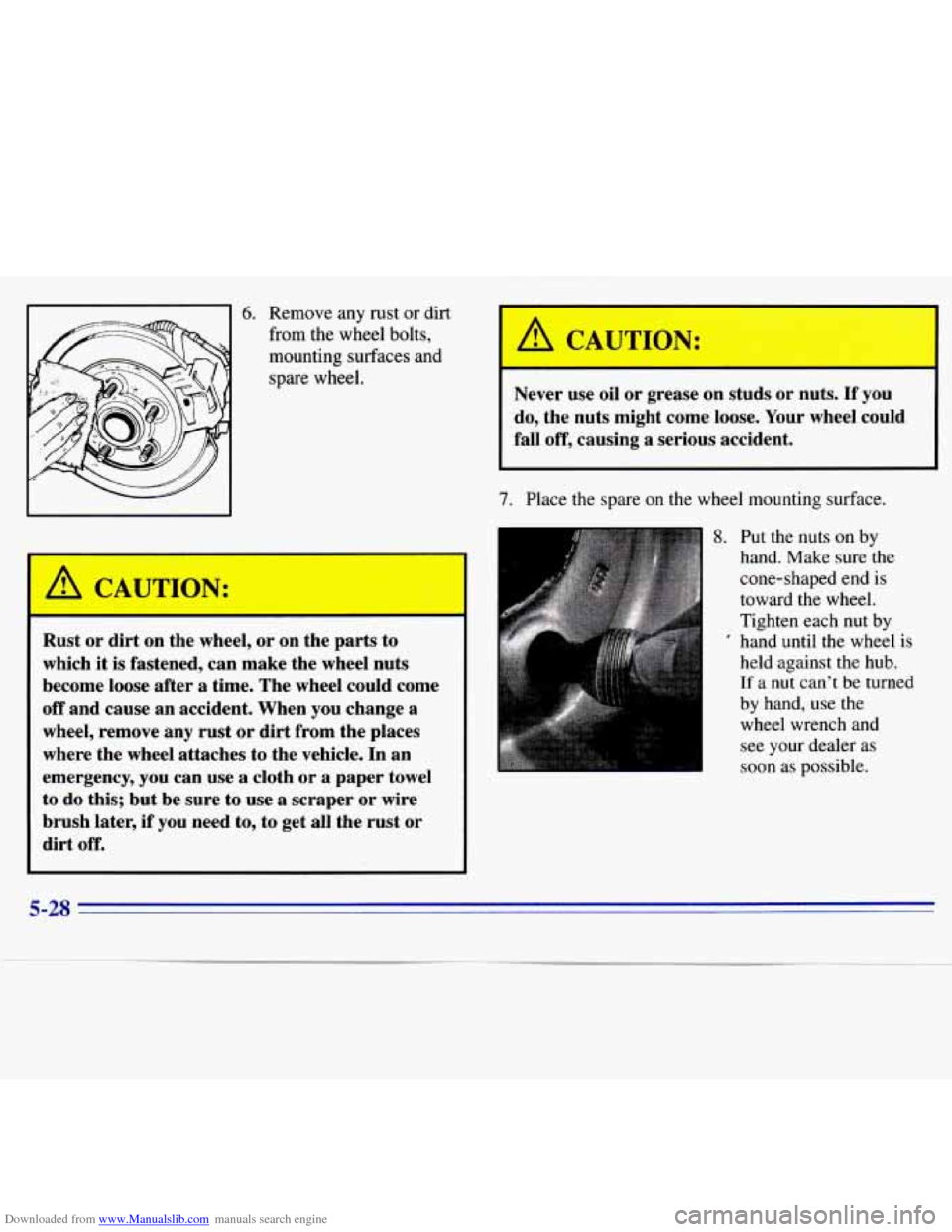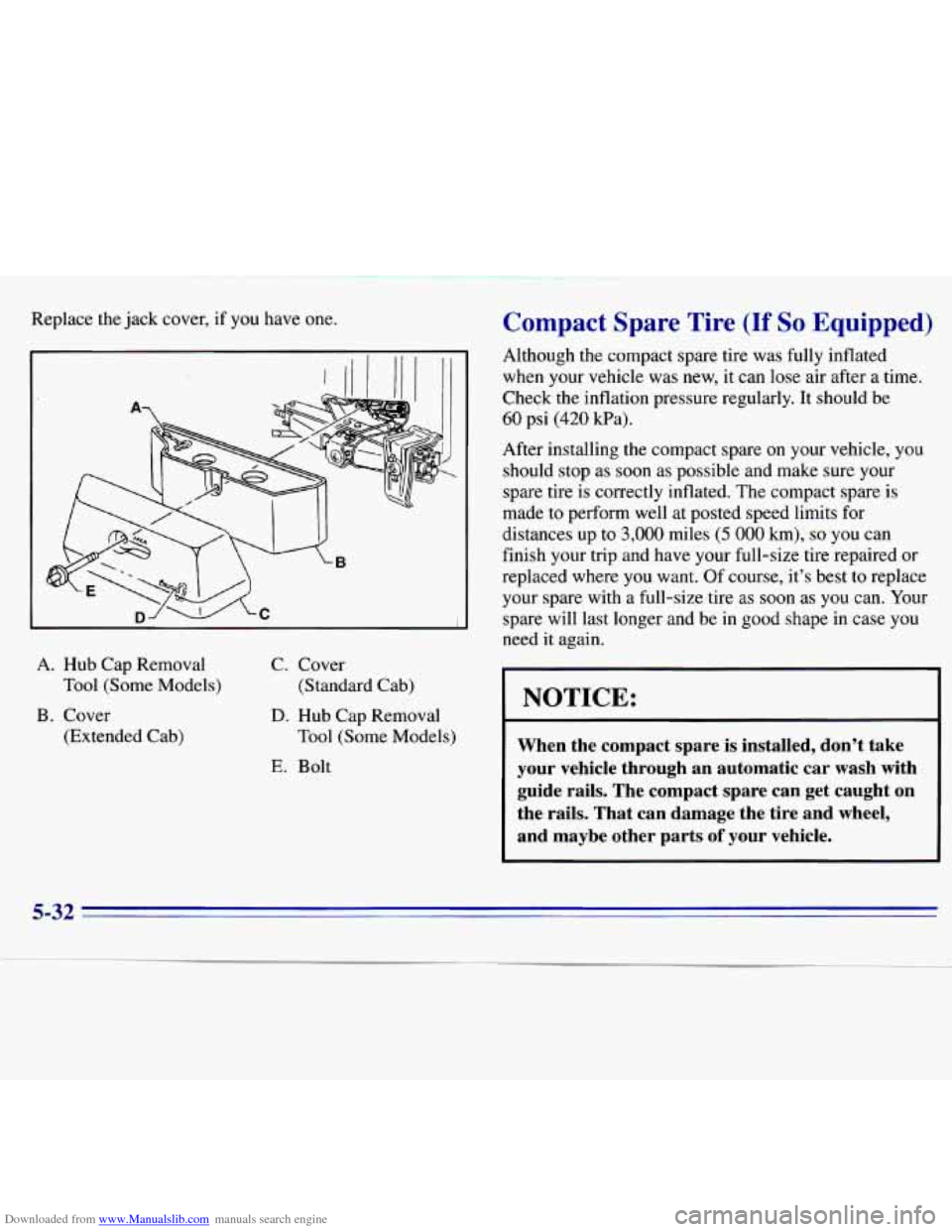Page 215 of 375
Downloaded from www.Manualslib.com manuals search engine If your jack storage cover is
equipped with a hub cap
removal tool, position
the
hub cap removal tool in the
notch and pull straight away
from the wheel to avoid
potential damage to the hub
cap and wheel paint or
surface. Remove the
hub cap.
If you have an aluminum or plastic molded hub cap, pry
t off with the chisel end of your wheel wrench.
Use
the socket end of the wheel wrench to remove the
wheel nut caps.
Some of the molded plastic hub caps have imitation
wheel nuts molded into them. Don't try
to remove them.
The wheel wrench socket won't fit these imitation nuts.
5-25
Page 216 of 375
Downloaded from www.Manualslib.com manuals search engine Removing the Flat Tire and
Installing the Spare Tire
1. Using the wheel wrench, loosen all the wheel nuts.
2. Turn the jack handle clockwise slightly to raise the
Don't remove them yet.
lift head.
3. Fit the jack into the appropriate hole nearest the
flat tire.
I.
y:
k-
A. Front Frame Hole
B. Rear Frame Hole (ZR2)
C. Spring Hanger Hole (Standard Pickups)
5-26
Page 217 of 375
Downloaded from www.Manualslib.com manuals search engine Getting under a vehicle when it is jacked up is
dangerous.
If the vehicle slips off the jack, you
could be badly injured or killed. Never get under
a vehicle when it is supported only by a jack.
I NOTICE:
Raising your vehicle with the jack improperly
positioned will damage the vehicle or may allow
the vehicle to fall off the jack.
Be sure to fit the
jack lift head into the proper location before
raising your vehicle.
4. Raise the vehicle by turning the jack handle
clockwise. Raise
the vehicle far enough off the
ground
so there is enough room for the spare tire
to fit.
5. Remove all the wheel nuts and take off the flat tire.
Page 218 of 375

Downloaded from www.Manualslib.com manuals search engine 6. Remove any rust or dirt
from the wheel bolts,
mounting surfaces and spare wheel.
I
A CAUTION:
Rust or dirt on the wheel, or on the parts to
which it
is fastened, can make the wheel nuts
become loose after
a time. The wheel could come
off and cause an accident. When you change a
wheel, remove any rust or dirt from the places
where the wheel attaches to the vehicle. In an
emergency, you can use
a cloth or a paper towel
to do this; but be sure to
use a scraper or wire
brush later, if you need to, to get all the rust or
dirt off.
1
Never use oil or grease on studs or nuts. If you
do, the nuts might come loose. Your wheel could
fall
off, causing a serious accident.
7. Place the spare on the wheel mounting surface.
8. Put the nuts on by
hand. Make sure the
cone-shaped end is
toward the wheel.
Tighten each nut by
’ hand until the wheel is
held against the hub.
If a nut can’t be turned
by hand, use the wheel wrench and
see your dealer as
soon as possible.
5-28
Page 219 of 375
Downloaded from www.Manualslib.com manuals search engine 9. Lower the vehicle by turning the jack handle
counterclockwise. Lower
the jack completely.
10. Use the wrench to
tighten the wheel
nuts
firmly in a
i crisscross sequence
i as shown.
d CAUTION:
I
I
Incorrect wheel nuts or improperly tightened
wheel nuts can cause the wheel to become loose
and even come
off. This could lead to an accident.
Be sure to use the correct wheel nuts.
If you have
to replace them, be sure to get new
GM original
equipment wheel nuts.
Stop somewhere as soon
as you can and have
the nuts tightened with
a torque wrench to
95 lb-ft (130 Nom).
I NOTICE:
Improperly tightened wheel nuts can lead to
brake pulsation and rotor damage.
To avoid
expensive brake repairs, evenly tighten the wheel
nuts in the proper sequence and to the proper
torque specification.
5-29
Page 220 of 375
Downloaded from www.Manualslib.com manuals search engine Storing a Flat or Spare Tire and Tools
-- I
Storing a jack, a tire or other equipment in the
passenger compartment
of the vehicle could
cause injury. In
a sudden stop or collision, loose
equipment could strike someone. Store
all these
in the proper place.
I
I NOTICE:
Don’t use the existing hoist to store a tire with an
aluminum wheel or it could damage the wheel.
Secure the tire in the pickup bed. Follow
this diagram
to store a tire that doesn’t have an
aluminum wheel.
A. Wheel Wrench
B. Hoist Assembly
C. Retainer
D. Spring
E. Tire
E Valve Stem
(Pointed
Down)
G. Lower
H. Raise
5-30
Page 221 of 375
Downloaded from www.Manualslib.com manuals search engine 1. Put the tire on the ground at the rear of the vehicle,
with the valve stem pointed down and to the rear.
2. Pull the retainer through the wheel.
Note that with the ZR2 option, the spring and
retainer must be separated
to insert through the
wheel opening.
3. Put the chisel end of the wheel wrench, on an angle,
through the hole in the rear bumper and into the hoist
shaft. Turn the wheel wrench clockwise until the tire
is raised against the underside
of the vehicle.
You will hear two “clicks” when the tire is secure,
but pull
on the tire to make sure. Return
the jack, wheel wrench and wheel blocks to the
proper location behind the seat. Secure the items.
A. Wheel Wrench E. Bolt Location (ZR2)
B. Bracket
C. Jacking Instructions
(Roll and place tag
behind the bracket after the tools are
installed.)
D. Bolt Location (Standard)
E Wheel Blocks
G. Nut
H. Rubber Band
I. Jack Position (ZR2)
J. Jack Position
(Standard)
5-31
Page 222 of 375

Downloaded from www.Manualslib.com manuals search engine Replace the jack cover, if you have one.
A. Hub Cap Removal
Tool (Some Models)
B. Cover
(Extended Cab) C.
Cover
(Standard Cab) D. Hub Cap Removal
E. Bolt Tool
(Some Models)
Compact Spare Tire (If So Equipped)
Although the compact spare tire was fully inflated
when your vehicle was new,
it can lose air after a time.
Check the inflation pressure regularly. It should be
60 psi (420 Pa).
After installing the compact spare on your vehicle, you
should stop as soon as possible and make sure your
spare tire is correctly inflated. The compact spare is
made to perform well at posted speed limits for
distances up to
3,000 miles (5 000 km), so you can
finish your trip and have your full-size tire repaired or
replaced where you want.
Of course, it’s best to replace
your spare with
a full-size tire as soon as you can. Your
spare will last longer and be
in good shape in case you
need it again.
NOTICE:
When the compact spare is installed, don’t take
your vehicle through an automatic car wash
with
guide rails. The compact spare can get caught on
the rails. That can damage the tire and wheel,
and maybe other parts
of your vehicle.
5-32